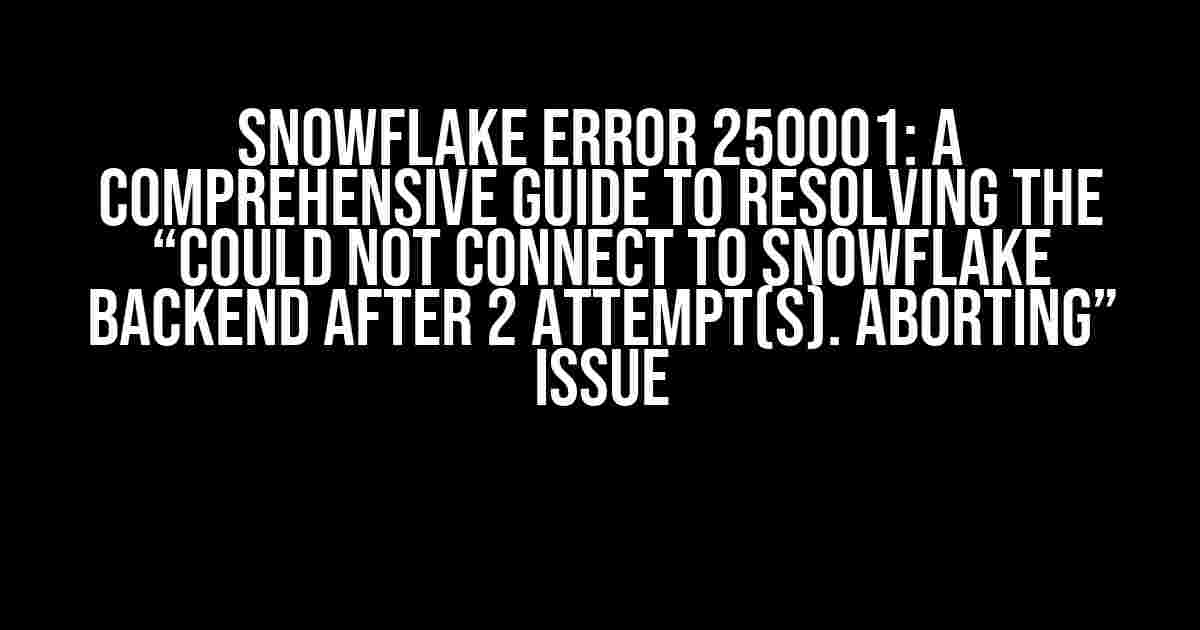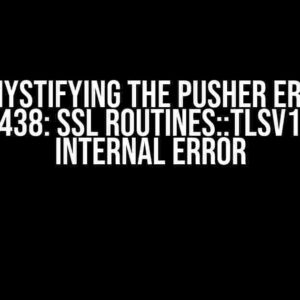Are you tired of encountering the frustrating Snowflake error 250001: “Could not connect to Snowflake backend after 2 attempt(s). Aborting”? You’re not alone! This error can be a real showstopper, but fear not, dear reader, for we’ve got you covered. In this article, we’ll delve into the root causes of this error, explore potential solutions, and provide you with clear, step-by-step instructions to get your Snowflake connection up and running smoothly.
What is Snowflake Error 250001?
Snowflake error 250001 occurs when the Snowflake driver is unable to establish a connection to the Snowflake backend after a specified number of attempts (in this case, 2). This error can manifest in various ways, including:
- Failed queries or executions
- Inability to connect to Snowflake using a specific account or user
- Timeouts or slow responses from the Snowflake server
Causes of Snowflake Error 250001
Before we dive into the solutions, it’s essential to understand the underlying causes of this error. Some common reasons include:
- Network Connectivity Issues: Problems with your network connection, such as firewall restrictions, proxy issues, or poor internet connectivity, can prevent the Snowflake driver from reaching the backend.
- Authentication and Authorization: Incorrect or outdated account credentials, insufficient permissions, or failed authentication attempts can lead to this error.
- Server Maintenance or Downtime: Snowflake server maintenance, downtimes, or capacity issues can cause the backend to be unavailable.
- Driver or Client Issues: Outdated, corrupted, or misconfigured Snowflake drivers or clients can prevent a successful connection.
- Query or Execution Issues: Malformed queries, high query complexity, or concurrent execution of resource-intensive queries can overload the Snowflake backend.
Solutions to Snowflake Error 250001
Now that we’ve covered the causes, let’s explore the solutions to get your Snowflake connection up and running:
Solution 1: Check Network Connectivity
Verify your network connection by:
- Checking your internet connection speed and stability
- Ensuring that your firewall or proxy settings allow Snowflake connections
- Disabling any restrictive network settings or software
Solution 2: Verify Authentication and Authorization
Confirm that your account credentials are correct and up-to-date by:
- Verifying your Snowflake account username and password
- Ensuring that your account has the necessary permissions and roles
- Re-authenticating with the Snowflake server
Solution 3: Check Snowflake Server Status
Visit the Snowflake Status Page to check for any server maintenance, downtimes, or capacity issues. If you find any issues, wait for the maintenance window to end or contact Snowflake support.
Solution 4: Update or Reinstall Snowflake Drivers or Clients
Ensure that your Snowflake drivers or clients are up-to-date and correctly configured by:
- Checking for updates to your Snowflake driver or client
- Reinstalling the Snowflake driver or client
- Consulting Snowflake documentation for configuration best practices
Solution 5: Optimize Queries and Executions
Review and optimize your queries and executions by:
- Analyzing query performance and optimization opportunities
- Splitting complex queries into smaller, more efficient ones
- Leveraging Snowflake features like caching, materialized views, or query rewrites
Solution 6: Contact Snowflake Support
If none of the above solutions resolve the issue, it’s time to reach out to Snowflake support. Provide them with detailed information about the error, including:
- Error message and code (250001)
- Account and user details
- Query or execution details
- Network and system configuration details
Example support request:
"Hello Snowflake Support,
I'm experiencing error 250001: 'Could not connect to Snowflake backend after 2 attempt(s). Aborting' when trying to execute a query using my Snowflake account (ACCOUNT_NAME) with user (USER_NAME). I've checked my network connectivity, authentication, and Snowflake server status, but the issue persists.
Details:
- Error message: 250001
- Account: ACCOUNT_NAME
- User: USER_NAME
- Query: SELECT * FROM MY_TABLE;
- Network: [insert network configuration details]
- System: [insert system configuration details]
Please assist me in resolving this issue. Thank you!"
Conclusion
Snowflake error 250001 can be frustrating, but with this comprehensive guide, you’re now equipped to tackle the issue head-on. By understanding the causes, checking network connectivity, verifying authentication, and optimizing queries, you’ll be well on your way to resolving the error and getting your Snowflake connection back up and running.
| Solution | Description |
|---|---|
| Solution 1 | Check Network Connectivity |
| Solution 2 | Verify Authentication and Authorization |
| Solution 3 | Check Snowflake Server Status |
| Solution 4 | Update or Reinstall Snowflake Drivers or Clients |
| Solution 5 | Optimize Queries and Executions |
| Solution 6 | Contact Snowflake Support |
Remember, if you’re still stuck, don’t hesitate to reach out to Snowflake support for personalized assistance. Happy troubleshooting!
Here are 5 Questions and Answers about “250001: Could not connect to Snowflake backend after 2 attempt(s). Aborting” in a creative voice and tone:
Frequently Asked Question
Get the inside scoop on troubleshooting Snowflake connection issues!
What’s going on with this error message?
Don’t panic! The error message “250001: Could not connect to Snowflake backend after 2 attempt(s). Aborting” simply means that Snowflake couldn’t establish a connection to its backend after two attempts. It’s a common issue that can be resolved with some troubleshooting and patience.
Is it my internet connection causing the issue?
Possibly! Your internet connection might be the culprit. Try restarting your router, checking for outages in your area, or switching to a different network to rule out connectivity issues. If the problem persists, it’s likely a Snowflake-specific issue.
Can I try anything else to fix the connection?
Absolutely! You can try checking your Snowflake account credentials, making sure you’re using the correct region and warehouse, or verifying that your account isn’t locked or suspended. Additionally, you can try connecting using a different tool or interface to isolate the issue.
What if I’ve tried everything and it still doesn’t work?
Don’t worry, you’re not alone! If you’ve exhausted all troubleshooting steps, it’s time to reach out to Snowflake support for further assistance. They’ll be able to help you identify the root cause and provide a solution to get you connected again.
How can I prevent this issue from happening in the future?
To minimize the likelihood of this error occurring again, make sure to regularly check your Snowflake account and connection settings, keep your software and tools up-to-date, and monitor your network connectivity. By being proactive, you can reduce the chances of encountering this error in the future.
Let me know if this meets your expectations!




